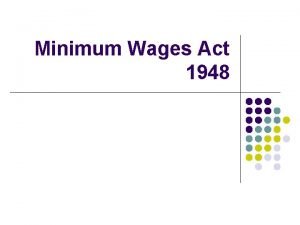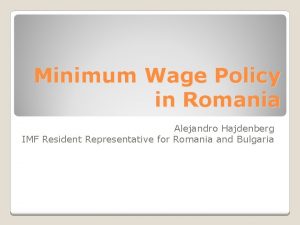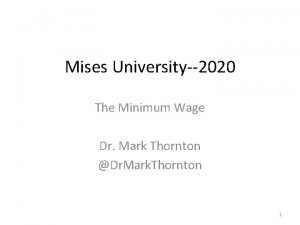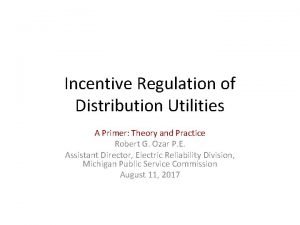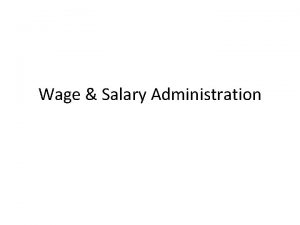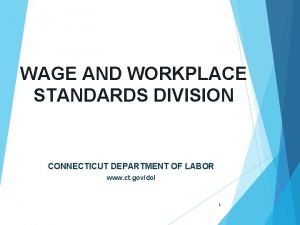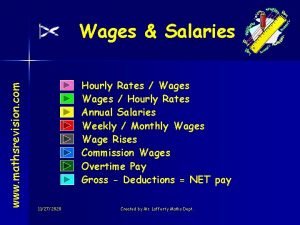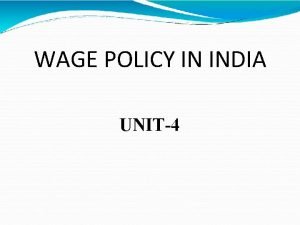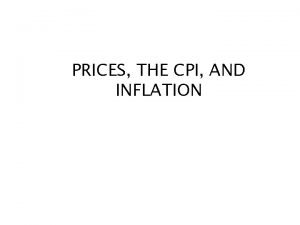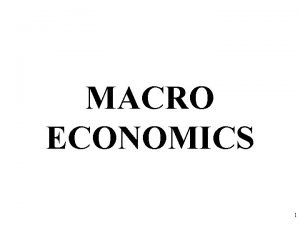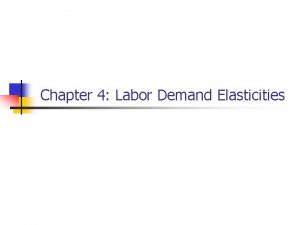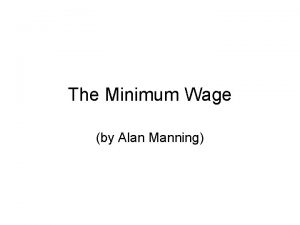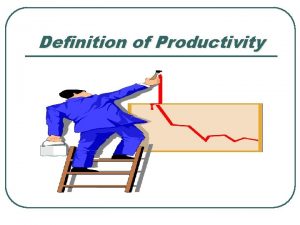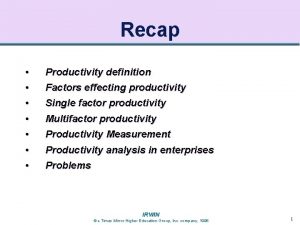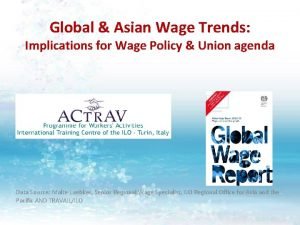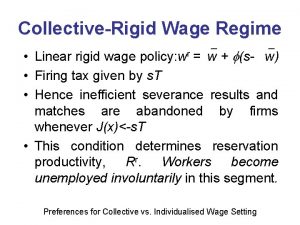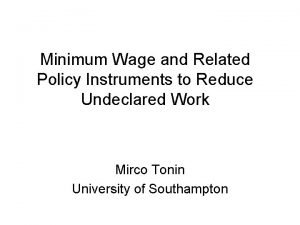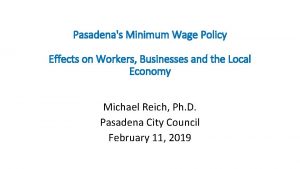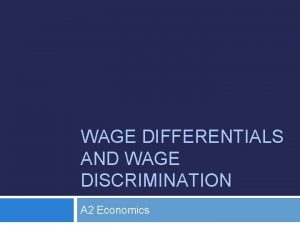Wage and Productivity Policy and Programs Minimum Wage




























- Slides: 28

Wage and Productivity Policy and Programs

Minimum Wage Setting

Wage Rationalization Act 3 Regional minimum wage fixing Institutional mechanisms NWPC – central coordinating body RTWPBs – set minimum wages Criteria Needs of workers and their families Employers’ capacity to pay Prevailing wages Requirements of social and economic development Frequency – annual Duration – 12 months

Minimum wage setting Regular, moderate and predictable wage adjustments Stable business planning horizon Not inflationary Coherent with BSP’s inflation target

5 Two-Tiered Wage System § Protect vulnerable workers from undue low wages § Increasingly link wage and productivity growth § Employers’ right to fair and reasonable profits § Workers’ share in the fruits of production

6 Two-Tiered Wage System § TIER 1 - Minimum Wage § Vulnerable or low paid workers § Higher than the poverty threshold but lower than average wages § Mandatory § TIER 2 - Productivity-based incentive system § All workers § Tighten the link between wage and productivity § Advisory, not mandatory

Daily Minimum Wage Rates in Agriculture by Region, Philippines: April 2018 500 450 400 350 300 250 200 150 100 50 0 NCR CAR Lowest Highest 475 270 300 I 256 265 II IVA IVB 320 302 350 303 372 259 300 V VI VIII 280 271. 5 288 290 281. 5 348 245 251 Source of data: National Wages and Productivity Commission/RTWPBs IX X XI XIII ARM M 283 304 326 335 272 290 255

Daily Minimum Wage Rates in Non-Agriculture by Region, Philippines: April 2018 600 500 400 300 200 100 0 NCR Lowest 475 Lowest 2 512 CAR 270 300 I 256 310 II 340 III 329 380 IVA 303 400 IVB 259 300 Source of data: National Wages and Productivity Commission/RTWPBs V 280 290 VI 271. 5 323. 5 VII 308 366 VIII IX X XI XIII ARMM 285 296 338 340 295 300 265

Number of Minimum Wage Categories by Region: as of March 2018 8 8 7 6 7 7 7 6 6 5 5 5 4 4 4 3 3 3 2 2 1 0 NCR CAR I II IVA IVB Source: National Wages and Productivity Commission/RTWPBs V VI VIII IX X XI XIII

Number of Minimum Wage Rates by Region: as of March 2018 14 14 Total: 75 12 10 9 10 8 8 5 6 5 4 4 3 4 2 2 3 2 2 2 1 2 0 NCR CAR I II IVA IVB V Source: National Wages and Productivity Commission/RTWPBs VI VIII IX X XI XIII

As floor wage, minimum wage should be about 70% of average wage Ratio of Highest MW to Ave. Wage (%) 80 Highest MW Average Wage NCR CAR I II 512 300 310 340 708 471 370 387 72 64 84 88 III IV-A IV-B V VI 380 378. 50 300 290 323. 50 441 509 343 360 400 86 74 87 81 81 Region Phils

As floor wage, minimum wage should be about 70% of average wage Region Highest MW Average Wage Ratio of Highest MW to Ave. Wage (%) VII 366 431 85 VIII 285 345 83 IX 296 366 81 X 338 405 84 XI 340 420 81 XII 295 407 73 XIII 300 411 73 ARMM 265 373 71

Limitations Imperfect coverage Exemption BMBE law Non compliance Distortion Enforcement /administration Limited number of compliance officers Complex wage orders (e. g. Region IVA)

Towards sustainable minimum wage policy Continuous simplification of wage structures to facilitate compliance and administration Categories down from 90 in 2016 to 73 at present Number of MWRs down from 90 in 2016 to 75 at present

NATIONAL CAPITAL REGION: March 2018 MW /AW 72% 708 800 475 600 400 200 0 343 512 MW CALABARZON: March 2018 600 Poverty 500 Threshold 300 Average Wage Poverty Threshold PT 400 SIMPLE AW MULTIPLE RATES AND CATEGORIES 509 372 373 400 367 347 339 337 336 333 303 317 318 327 328 Average Wage 200 100 0 PT MW AW

Towards sustainable minimum wage policy Set at levels: Not lower than PT to help workers and families meet basic needs Without approaching average wage so as not to crowd out bipartite negotiations and to ensure that minimum wage earners are not left too far behind compared to other workers Allows exemption to provide temporary relief to business enterprise and prevent job loss

Wage Structure, DAVAO REGION: March 2018 450 400 350 304 312 335 PT<MW<AW 340 Average Wage 300 250 200 420 Poverty Threshold 150 100 50 0 PT MW AW Wage Structure, WESTERN VISAYAS: March 2018 450 400 350 300 250 200 150 100 50 0 MW<PT<AW 271. 5 289 323. 5 Average Wage Poverty Threshold MW MW PT 400 MW AW

Towards sustainable minimum wage policy Allows exemption to provide temporary relief to business enterprise and prevent job loss

Regions With and Without Exemption Provisions in Wage Orders: March 2018 19 Without exemption CAR IVB V VIII XI XII Source: National Wages and Productivity Commission/RTWPBs NCR I II III With IVA VI exemption IX X XIII

Regions with Exemptible Categories in Wage Orders: as of March 2018 20 Exporters Est. Affected by Calamities NCR, I, III, IVA, VI, IX, X, XIII IVA NCR, I, III, IX, XIII NCR, I, III, IVA, VI, IX, X, XIII Distressed Establishment s I, II, VI, IX, XIII NBEs R/S Employing Not More Than 10 Source: National Wages and Productivity Commission/RTWPBs

Towards sustainable minimum wage policy Based on empirical data CPI, poverty threshold, average wage, gross regional domestic product, labor force, etc Ensures broad consultation of stakeholders Requires the conduct of a public hearing prior to issuance of a WO Strong tripartite presence

Outcomes Does not create inflationary pressure Difference in amount, timing and form Moderate and predictable increases; recovery of purchasing power Targets minimum wage earners only Coherent with fiscal and development policies (e. g. inflation targets, Chapter 10 of PDP 2017 -2022 cites strengthening of efficacy of MW policy as one of the strategies to improve income earning abilities)

Outcomes No evidence of any negative impact on employment Does not crowd out space for bipartite approaches in adjusting wages including schemes based on performance or productivity

Promoting Productivity Improvement

Linking wage and productivity growth Productivity improvement should lead to commensurate growth in wages and reasonable returns to investments for expansion and growth Promote inclusivity in growth Contribute to the attainment of PDP labor productivity growth target of 3% - 4% for the industry sector and 4% - 5% for the services sector

To date, the Boards have trained 378, 046 workers in 134, 426 enterprises in various productivity technologies Productivity Toolbox Positive work values Basic business processes Good housekeeping (7 S) Problem solving Error recovery Lean management Green technologies Service quality

Firms and Workers Trained in Productivity Improvement 350, 000 311, 890 300, 000 250, 000 200, 000 150, 000 105, 494 100, 000 50, 000 66, 156 28, 932 0 Firms inception to 2015 Workforce 2016 onwards

Building capacities of workers & enterprises Productivity Olympics Award system to showcase and recognize best practices 54 national winners to date Technical assistance in designing performance or productivity based incentive schemes 19 Advisories issued by the Boards Almost 2, 000 firms assisted since 2013
 Croatia minimum wage
Croatia minimum wage Minimum wage argument
Minimum wage argument The minimum wage act 1948
The minimum wage act 1948 Minimum wage romania
Minimum wage romania The minimum wages act 1948
The minimum wages act 1948 General statement
General statement Minimum wage
Minimum wage Slovakia minimum wage
Slovakia minimum wage Liberals vs conservatives minimum wage
Liberals vs conservatives minimum wage Jollibee entrepreneur
Jollibee entrepreneur Disadvantage of raising minimum wage
Disadvantage of raising minimum wage Local max
Local max Cpmcd full form
Cpmcd full form Ano ang price ceiling at price floor
Ano ang price ceiling at price floor Cjis network training v1 answers
Cjis network training v1 answers Emerson efficiency plan formula
Emerson efficiency plan formula Concept of wage and salary administration
Concept of wage and salary administration Wage and salary administration
Wage and salary administration Wage and workplace standards ct
Wage and workplace standards ct Mathsrevision.com
Mathsrevision.com What is a wage
What is a wage What is time rate wage system
What is time rate wage system Nominal gdp formula
Nominal gdp formula Mdot prevailing wage
Mdot prevailing wage Cpi and real gdp
Cpi and real gdp Muster roll register
Muster roll register Wage fund theory
Wage fund theory Own wage elasticity
Own wage elasticity Reservation wage
Reservation wage


